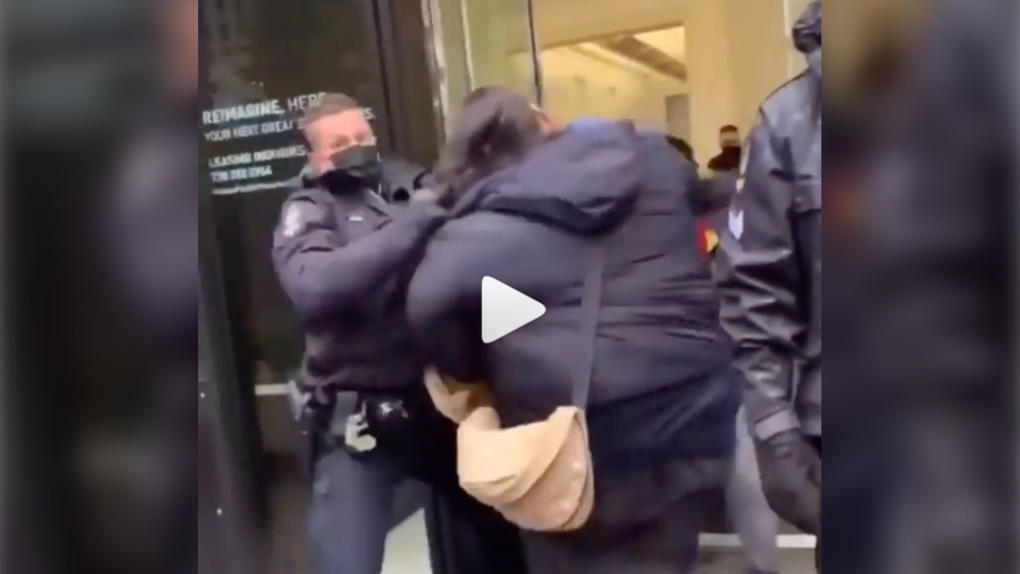Vancouver police officer who pulled Indigenous protester's braid unaware of 'cultural significance': review
 A still image of a video circulating on social media, which appears to have been taken at the Feb. 19 anti-pipeline protest, shows a Vancouver police officer pulling a protester forcefully by the hair (Instagram).
A still image of a video circulating on social media, which appears to have been taken at the Feb. 19 anti-pipeline protest, shows a Vancouver police officer pulling a protester forcefully by the hair (Instagram).
A Vancouver police officer who pulled an Indigenous protester's braid while forcefully removing them from a building acted lawfully, a review found. But training on how to account for "items of cultural significance" in use of force situations is being recommended.
A report coming to the Vancouver Police Board Thursday outlines the circumstances prompting the complaint, the findings of the review by the province's Office of the Police Complaint Commissioner and the recommendations to the VPD.
On Feb. 19, 2021, a group called Braided Warriors occupied the downtown lobby of a building where Trans Mountain pipeline insurer AIG has its offices. Video posted to social media showed the "forceful removal" of several demonstrators "including one officer who pulled the braid of an Indigenous person," the review of the complaint says.
The review was launched the next month and concluded in January of 2022. Commissioner Clayton Pecknold sent the findings – based on an investigation conducted by Metro Vancouver Transit Police – to the Vancouver Police Board in a letter dated April 25.
"The respondent member’s use of force in pulling the Indigenous person’s braid was lawful and in accordance with authorities, training, and policy," Pecknold wrote.
"The respondent member’s evidence was that he was not aware of the cultural significance of the braid and therefore did not consider its significance when he chose to grab the Indigenous person’s braid as a means of removing the individual from the building."
It was that finding that prompted the recommendation that the department review its training, policies and procedures, particularly but not exclusively when it comes to use of force.
"It is apparent that the respondent member’s lack of training and understanding with respect to items of cultural significance in use of force situations was a factor in the conduct that was the subject of this investigation," Pecknold continued.
The Truth and Reconciliation Commission's final report contains multiple accounts from residential school survivors who described having their long, braided hair cut upon arrival, describing it as one of the ways those institutions practiced cultural genocide by trying to erase their identity.
"The assault on Aboriginal identity usually began the moment the child took the first step across the school’s threshold. Braided hair (which often had spiritual significance) was cut," one of the commission's reports reads.
Acting on the recommendation stemming from the review, the report coming to the police board recommends that the department report back on, among other things, the question of how cultural considerations may be incorporated into the use of force policy, "recognizing that use of force encounters are inherently unpredictable, volatile, and may necessitate discretion and unique responses."
The incident that prompted the complaint to the OPCC was condemned by the Union of BC Indian Chiefs and the BC Civil Liberties Association as "horrifying" and "appalling" in a statement issued shortly after the video was posted online.
CTVNews.ca Top Stories

Police release bodycam video of officer-involved incident at Hindu temple protest in Brampton, Ont.
Police say an officer who forcefully removed a 'weapon' from a protester outside of a Hindu temple in Brampton was acting 'within the lawful execution of his duties' after bystander video of the incident circulated widely online.
RCMP begins deploying body-worn cameras to frontline officers across Canada
Within days, thousands of frontline RCMP officers will be starting their shifts equipped with a body-worn camera, as the national police force begins deploying the program across Canada.
'Countless lives were at risk:' 8 charged, including teen wanted in deadly home invasion, after West Queen West gun battle
A teenage boy arrested along with more than 20 others following a gun battle in Toronto’s West Queen West neighbourhood was wanted in connection with a deadly home invasion in Etobicoke back in April, Toronto police say.
Here's how a potential Canada Post strike may affect Canadians
A disruption in Canada Post services would hit some Canadians harder than others. As the deadline approaches for a potential strike at midnight Friday, CTVNews.ca asked readers how it would affect them and how they are preparing.
Scotiabank users facing 'intermittent' access to banking
Scotiabank users say they are having issues using their bank’s services following a scheduled maintenance period that ended days ago.
Everything is under US$20 at Amazon's newest store
Amazon is targeting retail rivals Shein, Temu and TikTok Shop with a new deeply discounted storefront that sells a wide array of products for US$20 or less.
W5 Investigates Car security investigation: How W5 'stole' a car using a device we ordered online
In part two of a three-part series into how thieves are able to drive off with modern vehicles so easily, CTV W5 correspondent Jon Woodward uses a device flagged by police to easily clone a car key.
Many long COVID patients adjust to slim recovery odds as world moves on
There are certain phrases that Wachuka Gichohi finds difficult to hear after enduring four years of living with long COVID, marked by debilitating fatigue, pain, panic attacks and other symptoms so severe she feared she would die overnight.
Marble bust bought for US$6 and used as doorstop could sell for more than US$3 million
A sculpture bought for just £5 (US$6) and used as a doorstop could sell for more than £2.5 million (US$3.2 million) after a Scottish court gave the green light for its sale.

































